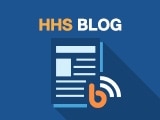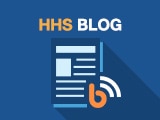#IAmHHS: Helping U.S. Communities Recover after a Disaster
Over my career at HHS, I’ve assisted communities across America in recovering from more than 30 different disasters. So I’m often asked, which was the worst disaster you worked on?
I can’t answer that. If you’re the person whose home, business or school was destroyed, it’s the worst hurricane, earthquake, tornado, flood, or incident ever. You simply cannot compare disasters. Every disaster is different; every community is different. Instead, what matters is to peel back the layers of the onion and see how a community has been affected by the disaster. Whether that is a Hurricane Harvey or the creek that floods out one house, all are devastatingly difficult for the people affected.
I lead disaster recovery for HHS within the Office of the Assistant Secretary for Preparedness and Response, or ASPR. Recovery is the stage after the life-saving activities have concluded in the disaster response, and it can last for years. We work with partners across the federal government and localities to deal with the health and social service needs that communities have.
When I’m not in the field, I’m meeting with our partners across the country or I’m in the Secretary’s Operations Center, the SOC, our information hub for disaster response and recovery. The 2017 hurricane season was intense, with one massive storm after another in different parts of the country. Each time, HHS and other partners were on hand to bring medical help, supplies and hope. In fact, ASPR teams are still supporting those missions today. We still have nearly 50 people in Puerto Rico; eight in Texas; about 10 in the U.S. Virgin Islands; and while our onsite support in Florida has concluded, we continue to support the Floridians who are still working on their recovery.
In support of the recovery missions following hurricanes Harvey, Irma and Maria, we’re focused on rebuilding community capacity and working with our state and local partners to deal with issues that happen after the disaster to put them in the best position to lead their recovery in the months and years to come. It’s their recovery, not ours. Our job is to help close the distance between the community in need and the resources available. Whether the needed resource is information, knowledge or rebuilding funding, we work with the community to try to make the process more efficient and more effective.
The 30-some major disaster recovery missions I’ve participated in include Hurricane Katrina, Hurricane Sandy, national-level drought, floods in Alaska, and powerful tornadoes across Arkansas, Missouri, Alabama and Oklahoma. At ASPR, we are continually working with states and communities to be ready to respond to and recover from the next disaster, whether it’s a natural disaster, technological disaster, act of terrorism, or biological incident.
Public service is where I feel I can make the most difference. Last year, lots of people from agencies throughout HHS joined hurricane response and recovery teams and deployed for their first time. Sometimes it can be very intimidating when you first arrive after a major disaster; you show up in an area that has debris piles that can go as high as a house, and then you look at that debris pile and you realize that was someone’s house. Everything a person worked their entire lives for could be piled up on the side of the road. It can be overwhelming. Despite that, HHS staff who supported the recovery efforts often said afterward that they want to do it again!
These communities that experience disasters, they didn’t ask for it. Nature is not discriminating. It’s the great equalizer. It is an honor and a great mission to be able to assist when people’s lives are upended in a single moment. Individuals, families and community leaders find themselves standing in the aftermath of the incident wondering, “What’s next?” And then we arrive. We’re not there to undo the damage, but to help them take those next steps.
I'm Josh Barnes. I help rebuild communities after disasters, and I am HHS.
Josh is one of more than 79,000 people who make HHS run every day. You can share his story and see others on Twitter and Facebook using #IAmHHS.
Honor National Immunization Awareness Month
A Fresh Start: Living in Recovery and Gaining Self-Sufficiency


